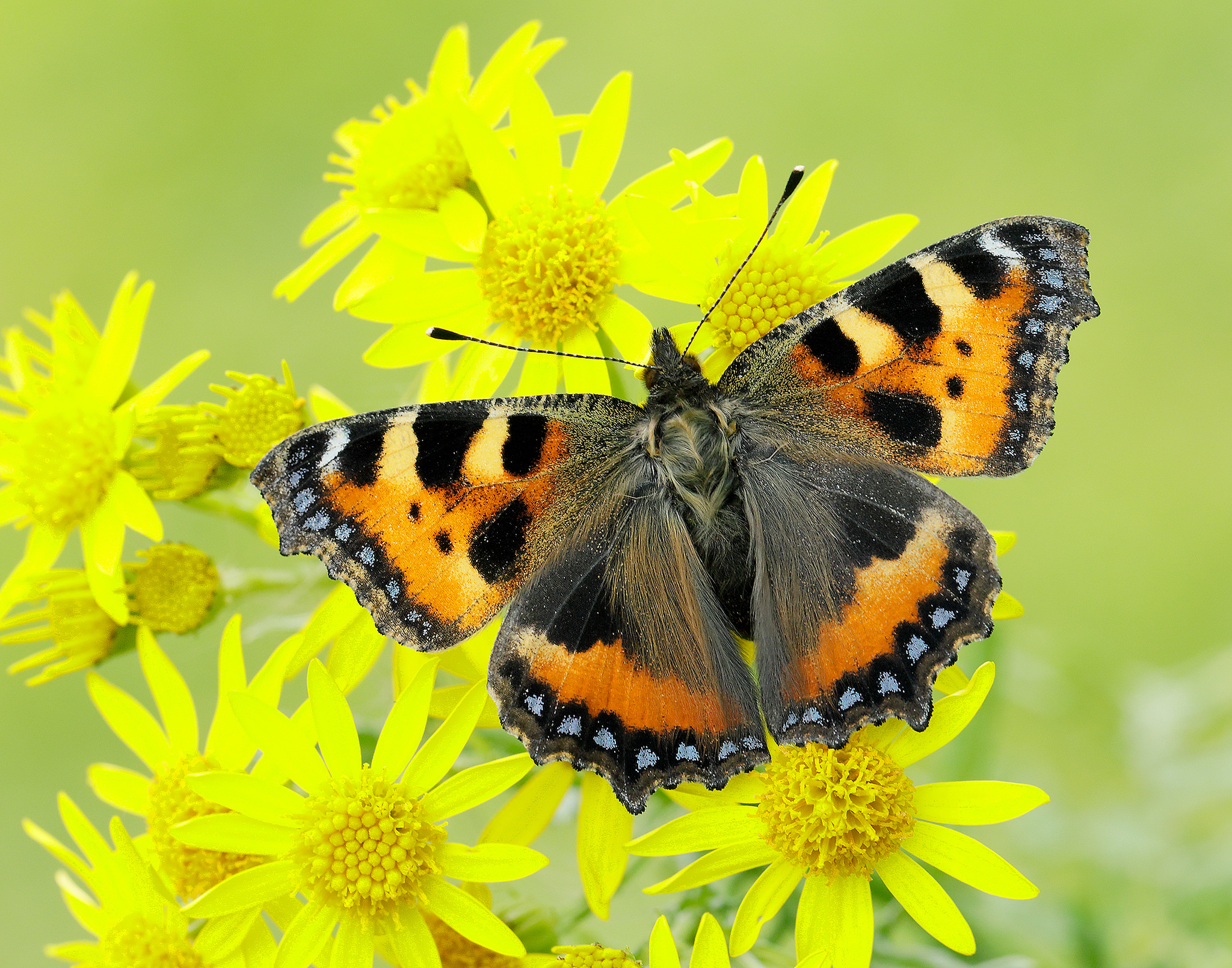Despite the recent dreary weather – high summer is supposedly upon us. August is traditionally holiday season so more time spent in the garden will hopefully reward you with sightings of Big Butterfly Count species like Peacock, Red Admiral, Small Tortoiseshell and Large White. Adult butterflies are easy to spot as they nectar in the flowerbeds but have you noticed any caterpillars enjoying your plants?
Butterflies A closer look at a patch of Common Nettle could reveal Red Admiral, Comma or Small Tortoiseshell caterpillars. Most Red Admiral eggs are laid in August. One egg is laid per tip, on the upper surface of a tender leaf. The egg hatches after about a week. Over the next four weeks, the caterpillar then spins a succession of progressively larger tents around itself by fastening a young leaf double with silk. Comma eggs are also laid singly and hatch after two to three weeks whereas Small Tortoiseshell eggs are laid in large clusters of 60 to 100 eggs, which hatch after 10 to 14 days.
A closer look at a patch of Common Nettle could reveal Red Admiral, Comma or Small Tortoiseshell caterpillars. Most Red Admiral eggs are laid in August. One egg is laid per tip, on the upper surface of a tender leaf. The egg hatches after about a week. Over the next four weeks, the caterpillar then spins a succession of progressively larger tents around itself by fastening a young leaf double with silk. Comma eggs are also laid singly and hatch after two to three weeks whereas Small Tortoiseshell eggs are laid in large clusters of 60 to 100 eggs, which hatch after 10 to 14 days.
Large White and Small White caterpillars are the bane of many a vegetable gardener. They will feed on any species of Brassica - such as Cabbages or Brussel Sprouts - but can be tempted away by Nasturtiums. Large White eggs are yellow, bottle-shaped and laid in neat groups of 50 to 100, usually on the underside of the leaves. Small White eggs are not in such massive clusters.
Moths
Many of the UK’s 2,500 species of moths can be found in gardens. The greater the mix of plants the wider the variety of moths as some of their caterpillars feed on tree leaves, some on grasses and some on herbaceous plants.
Willow or Sallow trees Salix spp. are a foodplant for more than 90 moth species. The Contorted Willow, or Corkscrew Willow, Salix babylonica var. pekinensis 'Tortuosa' will reach a height of 15m and spread of 8m when planted in the ground but in a small garden you can grow it in a container. This hardy, deciduous, upright tree easily grows from cuttings. It is popular with flower arrangers as the twisted stems add dramatic structure to displays. A branch from a flower arrangement stuck in some soil will often grow, as it did in a pot in my garden, although the best time to take cuttings is in spring, before the leaves emerge.
Three large Puss Moth caterpillars enjoyed stripping the leaves from my small (2.5m high) tree. The caterpillars are not only striking but also feisty - when disturbed they raise their head and wave their twin tails, which have pinkish, extendable whips.
The good news is that after the caterpillars had pupated, in a hard cocoon at the base of the trunk, the tree quickly recovered and was soon covered in leaves again. These caterpillars can be seen from July to Sep, also feeding on Goat Willow and poplar Populus spp such as Aspen Populus tremula. They overwinter as a pupa and the fluffy, white, adult Puss Moth is on the wing from May to July and can be seen throughout most of Britain.
Another caterpillar which feeds on poplar, aspen and sallow is the Poplar Hawk-moth. Distributed commonly throughout most of Britain, the adults are on the wing from May to September.
The Garden Tiger moth flies late at night in July and August. It was once a quite common moth in most of Britain but it seems to have declined in many places. The 'woolly bear' caterpillars feed on a number of herbaceous plants and can be seen from August, through the winter to late June.
I hope you enjoy sharing your garden with the hungry hordes. It’s worth a few missing leaves for the pleasure of seeing the adults flying around later!
Happy Gardening!
The Secret Gardener


